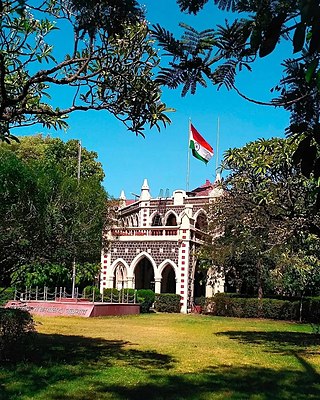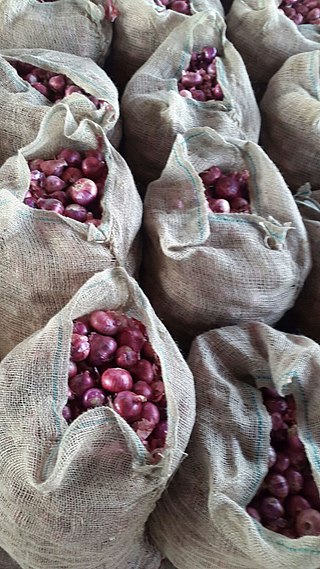Related Research Articles

Jalgaon district is a district in Maharashtra, India. Its headquarters is the Jalgaon city.
Lasalgaon is a census town in Nashik District in the Indian state of Maharashtra.

Banganapalle mangoes is a mango variety produced in Banganapalle of Nandyal District in the Indian state of Andhra Pradesh. It alone occupies 70% percent of total mango cultivable area of the state and was first introduced by the farmers of Banaganapalli. It was registered as one of the geographical indication from Andhra Pradesh on 3 May 2017, under horticultural products by Geographical Indication Registry. It is also grown in the other parts of India and Pakistan. The fruit is described as obliquely oval in shape, around 20cm in length, with yellow flesh and a thin, smooth yellow skin. The flesh is of a firm, meaty texture and is sweet and lacks fibre. The cultivar is the most sought after in Andhra Pradesh. It is a very late-season variety that is good for canning. This cultivar is a source of vitamin A & C and is also called king of Mangoes.

Khandesh is a geographic region in Maharashtra, India. It was made up of present Jalgaon, Dhule and Nandurbar districts. It also said that Burhanpur District of Madhya Pradesh was also its part.
Chinawal is a village in the Jalgaon district of Maharashtra state, India, in the foothills of the Satpura range with a generally hot and dry climate.

Bangalore rose onion, locally called gulabi eerulli, is a variety of onion grown in and around Bangalore in Karnataka. It received the Geographical Indication tag in 2015.

The Nanjangud banana is a variety of banana from Nanjangud, Mysore district, Karnataka. This fruit has a unique taste and aroma, and is locally popular. It has been given Geographical Indication Tag Number 29, which helps protect and promote the unique identity of the banana.
North Maharashtra is a geographical region of Maharashtra State, India. The region is composed of Nashik, Dhule, Nandurbar, and Jalgaon districts. It borders the state of Gujarat to the northwest, Paschim Maharashtra to the south, Konkan to the west, and the Vidarbha and Marathwada regions of Maharashtra to the east.

Shahi litchi is a variety of litchi grown in Muzaffarpur district and 2nd men rolling Mehsi and some neighbouring districts of in the Indian state of Bihar.
The 'Marathwada Kesar mango', is a mango cultivar primarily grown in Marathwada region of Maharashtra, India. Districts where they are primarily grown are Chhatrapati Sambhaji Nagar, Jalna, Beed and Latur.
The Mizo chilli is a variety of chilli mainly grown in the Indian state of Mizoram. It is a common and widely cultivated crop in Mizoram, and also found in parts of Manipur.

The Kolhapur jaggery is a variety of jaggery made from fresh sugarcane juice in the Indian state of Maharashtra. It is an agri-product manufactured from sugarcane which is a common and widely cultivated crop in Kolhapur. The waters of the streams forming the Panchganga river are primarily used for sugarcane cultivation in Kolhapur. It is also the most exported variety of jaggery from India.
Ajara Ghansal is a variety of non-Basmati aromatic rice mainly grown in the Indian state of Maharashtra. It is a common and widely cultivated crop in Ajara taluka of Kolhapur district.
Jalgaon Bharit Brinjal is a variety of brinjal grown in the Indian state of Maharashtra. It is a common and widely cultivated crop in areas like Asoda, Bamnod, Mamurabad, Bhadli, Bhalod and Bhusaval of Jalgaon district located in the Khandesh region of North Maharashtra.

Agassaim Brinjal is a variety of brinjal grown in the Indian state of Goa. It is a common and widely cultivated tropical vegetable crop in the village of Agassaim (Aagshi) located in Tiswadi taluka along with similar coastal parts of Tiswadi of North Goa district. It is also cultivated in the coastal parts of Mormugao and Salcete talukas South Goa district.
Vellore Spiny brinjal is a variety of brinjal grown in the Indian state of Tamil Nadu. It originated as a tropical vegetable crop from the village of Elavambadi located in Vellore district. It is primarily cultivated in the Vellore district, specifically in the areas of Anaicut, Kaniyambadi, Gudiyatham, K V Uppam, Vellore, Katpadi, and Pernambut.

Nayagarh Kanteimundi brinjal is a variety of brinjal grown in the Indian state of Odisha. It is now a common and widely cultivated crop in the whole of Nayagarh district of Odisha. This brinjal variety was originally cultivated in the areas of Badabanapur, Ratanpur in Kandapada block, and Dhanchangda, Laxmiprasad, Kumundi, and Fategarh in Bhapur block.
Lasalgaon onion is a variety of red onion grown in the Indian state of Maharashtra. It is a common and widely cultivated crop in Lasalgaon located in the Niphad taluka of the Nashik district. Lasalgaon has the largest onion market in India and the Asian continent. Significantly, the Lasalgaon onion market rate serves as a benchmark, influencing onion prices across the Asian market.
Alibag White onion is a traditional variety of white onion grown in the Indian state of Maharashtra. It is a common and widely cultivated crop in the Alibag taluka of the Raigad district. This unique onion is characterized by its sweetness, low pungency, and high nutritional value. It is traditionally cultivated in Alibag, specifically in villages such as Karle, Khandala, Nevuli, Talvali, Sagaon, and Wadgaon. It has been recognized since 1883 in the official gazette and known for its medicinal properties, for its health benefits, including treating heart ailments, controlling cholesterol, and regulating insulin.
Myndoli banana is a variety of banana grown in the Indian state of Goa. It is a common and widely cultivated crop in the villages of Pernem, Bicholim, and Bardez Taluka in North Goa district. Myndoli bananas are distinct due to their long, tusk-shaped appearance and larger size, setting them apart from other banana varieties in Goa. Under its Geographical Indication tag, it is referred to as "Myndoli Banana".
References
- ↑ "जळगावच्या केळीचा आखाती देशात गोडवा; यंदा होणार विक्रमी निर्यात". Maharashtra Times (in Marathi). Retrieved 16 December 2024.
- ↑ "World Banana Day 2024: Banana Growers in Maharashtra Demand 'Fruit' Status". Lokmat Times. Retrieved 16 December 2024.
- 1 2 3 "Jalgaon Banana" (PDF). Intellectual Property India. Retrieved 16 December 2024.
- ↑ "Doing what's kneadful to save bananas". MSN. Retrieved 16 December 2024.
- ↑ "How Jalgaon, 'Banana City of India', is fast becoming the 'Banana Republic'". Financialexpress. 18 June 2018. Retrieved 16 December 2024.
- ↑ Agricultural Situation in India. Manager of Publications, Civil Lines. 2004. Retrieved 16 December 2024.
- ↑ People's Raj. Directorate-General of Information and Public Relations. 1983. Retrieved 16 December 2024.
- ↑ "India starts exporting GI-certified Jalgaon banana to Dubai". mint. 16 June 2021. Retrieved 16 December 2024.
- ↑ BHARAMBE, Dr SANJAY N. AGRICULTURAL LAND UTILIZATION AND POPULATION CHANGES IN JALGAON DISTRICT (MAHARASHTRA) : A GEOGRAPHICAL ANALYSIS. Lulu.com. ISBN 978-1-365-24747-7 . Retrieved 16 December 2024.
- ↑ "India all set to get its first horticulture train". Hindustan Times. Retrieved 17 December 2024.
- ↑ "Lok Sabha elections 2024: Raver-Delhi banana train resumes services after 7 months". Mid-day. 7 May 2024. Retrieved 16 December 2024.
- ↑ "Jalgaon banana". Intellectual Property India. Retrieved 16 December 2024.
- ↑ Jadhav, Radheshyam (16 June 2021). "Jalgaon farmers export GI-certified banana to Dubai". BusinessLine. Retrieved 16 December 2024.
- ↑ "GI-certified Jalgaon bananas exported to Dubai". Deccan Herald. Retrieved 16 December 2024.